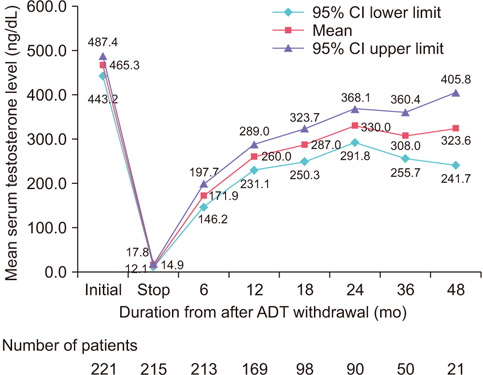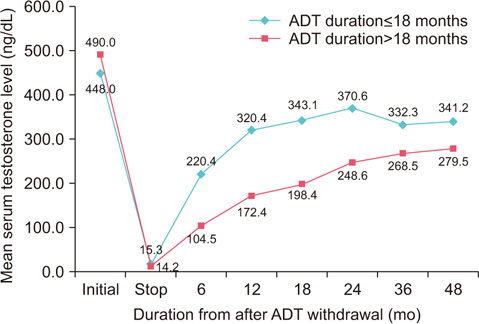Investig Clin Urol.
2018 Jan;59(1):18-24. 10.4111/icu.2018.59.1.18.
Factors associated with testosterone recovery after androgen deprivation therapy in patients with prostate cancer
- Affiliations
-
- 1Department of Urology, Asan Medical Center, University of Ulsan College of Medicine, Seoul, Korea. cskim@amc.seoul.kr
- 2Department of Urology, Seoul National University Boramae Medical Center, Seoul, Korea.
- KMID: 2399260
- DOI: http://doi.org/10.4111/icu.2018.59.1.18
Abstract
- PURPOSE
We investigated factors affecting testosterone recovery after androgen deprivation therapy (ADT) withdrawal in patients with prostate cancer.
MATERIALS AND METHODS
The medical records of patients who underwent radical prostatectomy with ADT were retrospectively reviewed. In all, 221 patients were included in the analysis. Testosterone recovery was defined as supra-castration (SC) (testosterone levels in serum >50 ng/dL) or out of hypogonadism (OH) (>300 ng/dL) after ADT withdrawal. Kaplan-Meier analyses were used to estimate testosterone recovery after ADT cessation. Cox regression analyses were used to determine the factors affecting the recovery of testosterone.
RESULTS
After ADT, 206 patients (93.2%) recovered to the SC level and 122 patients (55.2%) recovered to the OH level. Patients treated with ADT for ≤18 months recovered to OH in a mean of 6.8 months (74.6%), but patients treated with ADT for >18 months recovered in a mean of 9.7 months (27.5%). In multivariate analyses, age (hazard ratio [HR], 0.915; p < 0.001), serum level of sex hormone-binding globulin (SHBG) (HR, 1.015; p=0.002), initial testosterone level (HR, 1.002; p=0.002), and ADT duration (HR, 0.915; p < 0.001) were associated with recovery to the OH level after ADT withdrawal, and hypertension (HR, 0.697; p=0.029) and duration of ADT (HR, 0.979; p=0.012) were significantly associated with recovery to SC.
CONCLUSIONS
In patients treated with ADT for ≤18 months, testosterone recovers to the OH level more often and faster after ADT cessation. Age, SHBG level, initial testosterone level, and ADT duration are associated with testosterone recovery.
MeSH Terms
Figure
Cited by 1 articles
-
Efficacy of Androgen Deprivation Therapy in Patients with Metastatic Castration-Resistant Prostate Cancer Receiving Docetaxel-Based Chemotherapy
Kyungchan Min, Jae-Wook Chung, Yun-Sok Ha, Jun Nyung Lee, Bum Soo Kim, Hyun Tae Kim, Tae-Hwan Kim, Eun Sang Yoo, Tae Gyun Kwon, Sung Kwang Chung, Masatoshi Tanaka, Shin Egawa, Takahiro Kimura, Seock Hwan Choi
World J Mens Health. 2020;38(2):226-235. doi: 10.5534/wjmh.190029.
Reference
-
1. Klap J, Schmid M, Loughlin KR. The relationship between total testosterone levels and prostate cancer: a review of the continuing controversy. J Urol. 2015; 193:403–413.
Article2. Kamada S, Sakamoto S, Ando K, Muroi A, Fuse M, Kawamura K, et al. Nadir testosterone after long-term follow-up predicts prognosis in patients with prostate cancer treated with combined androgen blockade. J Urol. 2015; 194:1264–1270.
Article3. Nguyen PL, Alibhai SM, Basaria S, D'Amico AV, Kantoff PW, Keating NL, et al. Adverse effects of androgen deprivation therapy and strategies to mitigate them. Eur Urol. 2015; 67:825–836.
Article4. D'Amico AV, Denham JW, Crook J, Chen MH, Goldhaber SZ, Lamb DS, et al. Influence of androgen suppression therapy for prostate cancer on the frequency and timing of fatal myocardial infarctions. J Clin Oncol. 2007; 25:2420–2425.5. Salonen AJ, Taari K, Ala-Opas M, Viitanen J, Lundstedt S, Tammela TL, et al. Advanced prostate cancer treated with intermittent or continuous androgen deprivation in the randomised Finn Prostate Study VII: quality of life and adverse effects. Eur Urol. 2013; 63:111–120.6. Yoon FH, Gardner SL, Danjoux C, Morton G, Cheung P, Choo R. Testosterone recovery after prolonged androgen suppression in patients with prostate cancer. J Urol. 2008; 180:1438–1443. discussion 1443-4.
Article7. Murthy V, Norman AR, Shahidi M, Parker CC, Horwich A, Huddart RA, et al. Recovery of serum testosterone after neoadjuvant androgen deprivation therapy and radical radiotherapy in localized prostate cancer. BJU Int. 2006; 97:476–479.
Article8. Bong GW, Clarke HS Jr, Hancock WC, Keane TE. Serum testosterone recovery after cessation of long-term luteinizing hormone-releasing hormone agonist in patients with prostate cancer. Urology. 2008; 71:1177–1180.
Article9. Nejat RJ, Rashid HH, Bagiella E, Katz AE, Benson MC. A prospective analysis of time to normalization of serum testosterone after withdrawal of androgen deprivation therapy. J Urol. 2000; 164:1891–1894.
Article10. Planas J, Celma A, Placer J, Cuadras M, Regis L, Gasanz C, et al. Hormonal response recovery after long-term androgen deprivation therapy in patients with prostate cancer. Scand J Urol. 2016; 50:425–428.
Article11. Johansen TE, Ogreid P, Kjellevold K, Blom P. Testicular histology after treatment with LH-RH analogue for carcinoma of the prostate. Br J Urol. 1990; 65:376–378.
Article12. Crook JM, O'Callaghan CJ, Duncan G, Dearnaley DP, Higano CS, Horwitz EM, et al. Intermittent androgen suppression for rising PSA level after radiotherapy. N Engl J Med. 2012; 367:895–903.
Article13. van den Bergh RC, van Casteren NJ, van den Broeck T, Fordyce ER, Gietzmann WK, Stewart F, et al. Role of hormonal treatment in prostate cancer patients with nonmetastatic disease recurrence after local curative treatment: a systematic review. Eur Urol. 2016; 69:802–820.
Article14. Pedraza R, Kwart AM. Hormonal therapy for patients with advanced adenocarcinoma of the prostate: is there a role for discontinuing treatment after prolonged androgen suppression? Urology. 2003; 61:770–773.
Article15. Farnsworth WE. Roles of estrogen and SHBG in prostate physiology. Prostate. 1996; 28:17–23.
Article
- Full Text Links
- Actions
-
Cited
- CITED
-
- Close
- Share
- Similar articles
-
- Current Concepts in Androgen Deprivation Therapy
- Role of Androgen Receptor in Prostate Cancer: A Review
- Chemotherapy With Androgen Deprivation for Hormone-Naïve Prostate Cancer
- Predictive Factor for the Early Progression of Androgen Independent Prostate Cancer in Intermittent Androgen Deprivation Therapy
- Intermittent Androgen Deprivation with Goserelin and Flutamide for Prostate Cancer: a Pilot Study





